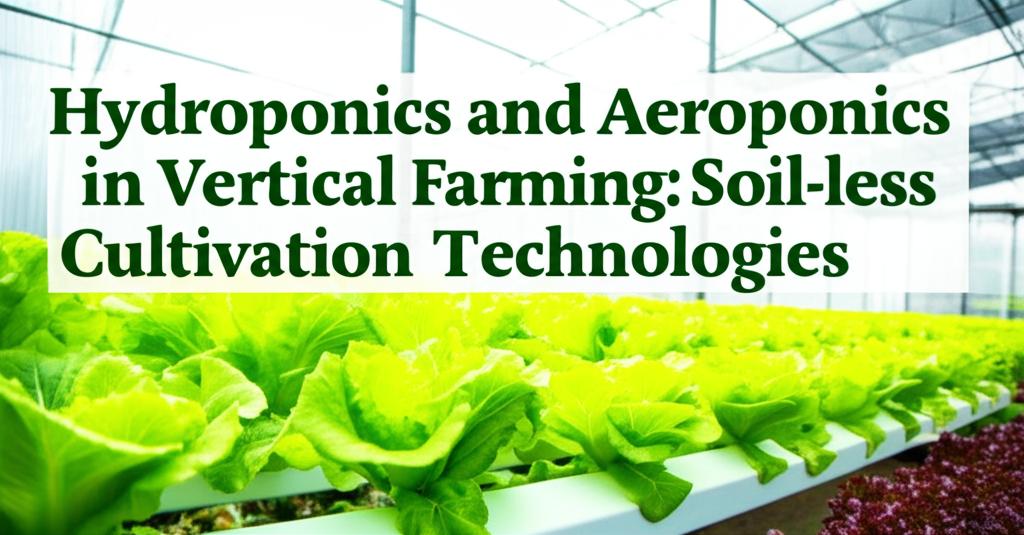Vertical farming is revolutionizing agriculture by growing crops in stacked layers, often in controlled indoor environments. This approach addresses challenges like shrinking arable land and the impacts of climate change on traditional farming. Two prominent soilless cultivation techniques central to vertical farming are hydroponics and aeroponics.
Understanding Soil-less CultivationSoil-less cultivation refers to methods of growing plants without using soil as a rooting medium. Instead, plants receive nutrients through water-based solutions or mist. These techniques are particularly well-suited for urban environments and allow for greater control over growing conditions.
Hydroponics in Vertical FarmingHydroponics involves growing plants with their roots submerged in a nutrient-rich water solution. Various inert mediums like perlite, coconut coir, or rock wool may be used to support the plants.
- How it Works: Plants receive precisely formulated nutrient solutions directly to their roots. These systems can be open, where the nutrient solution is used once, or closed, where it is continuously recycled.
- Advantages:
Water Efficiency: Hydroponic systems can use up to 90% less water than traditional soil-based agriculture due to water recycling and reduced evaporation.
Space Efficiency: Plants can be grown closer together and in vertical layers, maximizing yield per square foot. This makes it ideal for urban farming and areas with limited land.
Faster Growth and Higher Yields: Direct access to optimally formulated nutrients can lead to faster plant growth (30-50% quicker) and higher yields compared to conventional farming.
Reduced Pesticide Use: Controlled indoor environments minimize the risk of pests and soil-borne diseases, reducing or eliminating the need for pesticides.
Year-Round Production: Consistent crop production is possible regardless of external weather conditions or seasons.
Precise Nutrient Control: Farmers can precisely manage the nutrient composition, pH, and other growing conditions, leading to consistent crop quality.
- Challenges:
High Initial Costs: Setting up hydroponic systems requires a significant investment in infrastructure and technology.
Technical Expertise: Managing nutrient solutions, pH levels, and system operations requires specialized knowledge.
Energy Consumption: Artificial lighting and climate control systems can lead to high energy use, although advancements in LED technology and renewable energy integration are helping to mitigate this.
Waterborne Diseases: If not managed properly, waterborne diseases can spread rapidly through the system.
Limited Crop Variety: While excellent for leafy greens, herbs, and some vine crops, hydroponics can be challenging for root vegetables and staple grains.
Aeroponics in Vertical FarmingAeroponics is a method where plant roots are suspended in the air and periodically misted with a nutrient-rich solution. This technique was notably developed by NASA for growing plants in space.
- How it Works: Plant roots hang in an enclosed chamber and are sprayed with a fine mist of atomized nutrient solution. This ensures the roots have access to both nutrients and ample oxygen.
- Advantages:
Exceptional Water Efficiency: Aeroponics uses even less water than hydroponics, potentially up to 90% less than hydroponic systems and 95% less than traditional farming, as the nutrient solution is delivered directly to the roots via mist and can be recycled.
Enhanced Oxygen Availability: Exposed roots receive maximum oxygen, which can lead to faster growth rates and healthier plants compared to other methods.
Higher Yields: Precise nutrient delivery and optimal oxygenation often result in increased yields.
Reduced Disease Risk: The absence of soil and less water contact minimizes the risk of soil-borne and waterborne diseases.
Space Optimization: Ideal for vertical farming due to high-density cultivation possibilities.
- Challenges:
High Initial Costs: Aeroponic systems can be more expensive to set up than hydroponic systems due to the need for specialized misting equipment and precise control systems.
Technical Complexity: Requires a high level of technical expertise to manage the nutrient misting frequency, droplet size, and environmental controls.
Dependency on Power: The misting systems are reliant on electricity; power outages can quickly damage or kill plants if roots dry out.
System Sterility: Maintaining a sterile environment within the root chamber is crucial to prevent pathogen growth.
* Energy Consumption: Similar to hydroponics, energy for lighting and environmental control can be significant.
Recent Developments and TrendsBoth hydroponics and aeroponics are continually evolving with new technologies and approaches:
- Automation and AI: Robotic systems for planting, monitoring, and harvesting are becoming more common. AI algorithms optimize environmental conditions, nutrient delivery, and resource use.
- IoT Integration: Internet of Things (IoT) devices and sensors enable real-time monitoring and remote management of growing parameters like water quality, nutrient levels, temperature, and humidity.
- LED Lighting Advances: More efficient and customizable LED lighting systems allow for precise control over light spectra, improving photosynthesis and reducing energy consumption.
- Data Analytics: Big data and predictive analytics help farmers make informed decisions for better crop management and yield optimization.
- Sustainability Initiatives: Integration of renewable energy sources like solar and wind power, along with waste-to-energy solutions, are making these systems more environmentally friendly.
- Crop Diversification: Ongoing research is expanding the range of crops that can be successfully grown using these methods, including exploring staple crops and new varieties adapted for controlled environments.
- Urban Agriculture Expansion: The demand for locally grown, fresh produce in cities is driving the growth of urban vertical farms, including rooftop systems and container farms.
- Modular Farms: Prefabricated and scalable hydroponic and aeroponic units allow for quick setup in various urban spaces.
The choice between hydroponics and aeroponics depends on factors like budget, technical expertise, desired crop types, and specific operational goals. Hydroponics is generally considered easier to set up and manage, making it more accessible for beginners, though it uses more water than aeroponics. Aeroponics, while potentially offering faster growth and higher water efficiency, requires more significant investment and technical know-how.
Both hydroponics and aeroponics represent significant advancements in soil-less cultivation, offering sustainable and efficient solutions for modern agriculture, particularly within the context of vertical farming. As technology continues to advance, these methods are poised to play an increasingly vital role in global food security.

